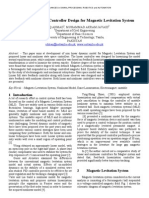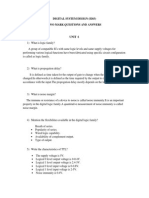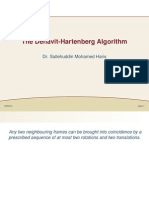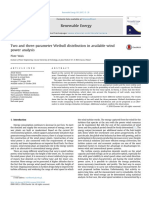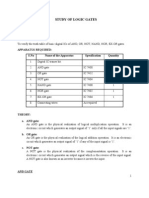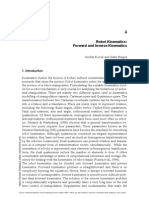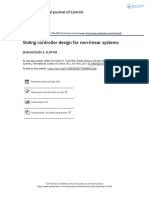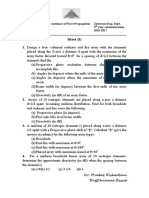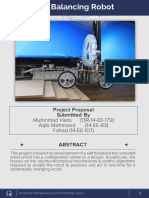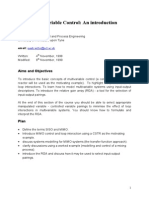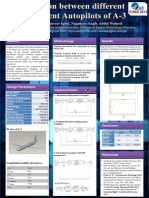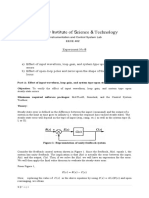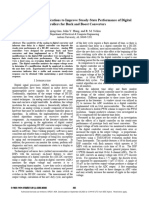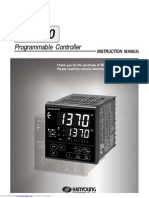Balancing Robot
Balancing Robot
Uploaded by
Milton MuñozCopyright:
Available Formats
Balancing Robot
Balancing Robot
Uploaded by
Milton MuñozCopyright
Available Formats
Share this document
Did you find this document useful?
Is this content inappropriate?
Copyright:
Available Formats
Balancing Robot
Balancing Robot
Uploaded by
Milton MuñozCopyright:
Available Formats
World Academy of Science, Engineering and Technology 79 2011
Two Wheels Balancing Robot with Line Following Capability
Nor Maniha Abdul Ghani, Faradila Naim, Tan Piow Yon
AbstractThis project focuses on the development of a line follower algorithm for a Two Wheels Balancing Robot. In this project, ATMEGA32 is chosen as the brain board controller to react towards the data received from Balance Processor Chip on the balance board to monitor the changes of the environment through two infra-red distance sensor to solve the inclination angle problem. Hence, the system will immediately restore to the set point (balance position) through the implementation of internal PID algorithms at the balance board. Application of infra-red light sensors with the PID control is vital, in order to develop a smooth line follower robot. As a result of combination between line follower program and internal self balancing algorithms, we are able to develop a dynamically stabilized balancing robot with line follower function. Keywordsinfra-red sensor, PID algorithms, line follower
Balancing robot
I.INTRODUCTION
VER the past decades, the research on two wheeled inverted pendulum mobile robot or commonly known as balancing robot have gain momentum in a number of robotic centers around the world due to natural unstable dynamics of the system. [1] Since a Two wheeled balancing robot need a good controller to maintain itself in upright position without the needs from external forces. Thus, providing a good platform for researcher to explore the efficiency of various controllers in control system based on the inverted pendulum model. Nowadays, various controllers are implemented on two wheeled balancing robot for example Linear Quadratic Regulator, Pole-Placement Controller, Fuzzy Logic Controller, and Proportional Integrated Derivative Controller. [3].A two wheeled balancing robot is categorized by the ability to balance on its two wheels and spin on the spot. As a result from this additional maneuverability, it allows easy navigation on the various terrains, turn sharp corner, and traverse small step or curbs and ability to carry loads. Two wheeled robots also have a small footprint than three or four wheeled robots thus enable it to travel around corridors and tight corners more easily. [4] These capabilities have the potential to solve many challenges in industry and society. As the two wheeled balancing robot has been investigated and developed to become human transport machine.The Segway, Pegasus, and iBot models are the example of the design of two wheeled balancing robot as a human transport machine. In addition, a motorised wheelchair utilising this technology would give the operator greater maneuverability and thus access to places most able-bodied people take for granted. Small carts built utilising this technology allows humans Nor Maniha Abdul Ghani is with Universiti Malaysia Pahang(email:normaniha@ump.edu.my)
to travel short distances in a small area or factories as opposed to using cars or buggies which is more polluting. [2] In this project, the two wheels balancing robot will not only solve the balancing problem but also automatically move around and avoid basic obstacles through the implementation of Dual ground Sensor and looking forward infrared sensor respectively. The Dual ground sensor is located at the bottom of the Balbot which is the infrared IR distance sensor, where ground sensors are used to measure the tilting angle. Powerful ATMEGA32 processor is used to be the brain of the robot. BEMP motor velocity sensor is used to obtain the speed of the platform. The entire controller algorithm will be computed in C programming and stored inside the microcontroller. Without an active control system, the robot would just fall over. Thus, the controller plays an important role in this project. Lastly, three pairs of infra-red sensor are used to guide the line follower task during balance state. II.LITERATURE REVIEW Conducting literature review prior to begin a research project is vital in understanding two wheels balancing robot control technique, as this will supply the researcher with much needed additional information on the methodologies and technologies available and used by other research counterparts around the world. This chapter provides a condensed summary of literature reviews on key topics related to balancing a two-wheeled robot. [2] Comparisons between the present project and the related topics of existing information will also be discussed. A. Previous Project Work A research professor at Carnegie Mellon University, Ralph Hollis who has developed a totally unique balancing robot that balances on top of a bowling ball. He calls his robot design BallBot [6, p. 72]. Mr. Hollis and his research associates believe that robots in the future will play a vital role in the daily lives of humans. He believes that in order for robots to be productive in our daily lives, some key problems need to be solved first. One the important problem he states in his article about mobile self balancing robots is the overall structure of the robot itself. (R. Hollis 2009)A researcher, Steve Hassenplug has successfully constructed a balancing robot called Legway using the LEGO Mindstorms robotics kit. Two Electro-Optical Proximity Detector sensors from HiTechnic Sensors to provide the tilt angle information and detect lines. The controller is programmed in high level programming language specifically created for LEGO Mindstorms which was written in brickOS (LegOS) and uses EOPDs to maintain a constant distance from the ground. As the distance decreases, Legway moves forward. As the distance increases,
634
World Academy of Science, Engineering and Technology 79 2011
Legway moves backward. Every 50 ms, Legway attempts to recalculate the balance point by measuring the current distance and motor speed. To move forward for line following, Legway actually sets the motors to run backward, causing a tilt, which it automatically corrects by moving forward. When one sensor is over the line, it stops that motor, and Legway balances using only the other motor, causing it to turn. To spin in place, both motors are shifted "off center" in opposite directions, the same amount, but they still correct for tilting. Legway uses its two optical proximity detectors to balance the two wheel LEGO robot. (Hassenplug S. 2003) nBot is a two-wheeled balancing robot built by David P. Anderson. This robot uses commercially available of the shelf inertial sensors and motor encoders to balance the system. Such inertial sensors that are used on nBot are an accelerometer and a gyroscope. The basic idea for a twowheeled dynamically balancing robot is pretty simple which is driving the wheels in the direction that the upper part of the robot is falling. If the wheels can be driven in such a way as to stay under the robot's center of gravity, the robot remains balanced. In practice this requires two feedback sensors: a tilt or angle sensor to measure the tilt of the robot with respect to gravity, and wheel encoders to measure the position of the base of the robot. Four terms are sufficient to define the motion and position of this "inverted pendulum" and thereby balance the robot. (Anderson D.P. 2003)As invented by Dean Kamen, the Segway PTs dynamics are identical to the inverted pendulum. For added mobility, the Segway is also based on the two wheel platform design. The advanced control algorithms behind the Segway transporter are a company trade secret. The basics of a Segway are computers that process the control algorithms, two tilt sensors, five gyroscopes, and two electric motors. Only three of the five gyroscopes are used to balance the Segway. The remaining two gyroscopes are used as backup. These critical components that make up a Segway are important to keep the vehicle in perfect balance. Current models of the Segway personal transporter can achieve top speeds of 12.5 mph. The Segway is able to navigate thru rough terrain, while successfully carrying a human onto of the platform. The Segway is typically found in urban settings; used for guided tours and city government officials. (Dean Kamen 2001)A researcher, Priyank Patil has successfully design and constructed a Line Follower Robot which wills sense a line and manoeuvring the robot to stay on course, while constantly correcting wrong moves using feedback mechanism forms a simple yet effective closed loop system. This robot is running on Atmel's AVR microcontrollers which have a RISC core running single cycle instructions and a well-defined I/O structure that limits the need for external components. Internal oscillators, timers, UART, SPI, pull-up resistors, pulse width modulation, ADC, analog comparator and watch-dog timers are some of the features you will find in AVR devices. AVR instructions are tuned to decrease the size of the program whether the code is written in C or Assembly. With on-chip in-system programmable Flash and EEPROM, the AVR is a perfect choice in order to optimize cost and get product to the market quickly. [8]
B. PID Control Systems The implementation and complexity difficulty associated with the nonlinear method causes most control researchers to utilize the linear controller approach. The method that will be used to control the self-balancing two wheeled robot will be a linear controller. It will be applied through a Proportional, Integral, and Derivative also refer to as the PID. The PID has proven to be popular among the control engineering community. As stated by the author of article Vance J. Van Doren, For more than 60 years after the introduction of Proportional-Integral-Derivative controllers, remain the workhorse of industrial process control [9]. III.METHODOLOGY The main purpose of this project is to upgrade a balancing robot to become a line follower Balbot. It involves the understanding of balancing system in the Balance Board which using PID controller as linear controller with Analog GP2D120 IR distance sensors as feedback input and the concept of line following system with the implementation of IR sensors as shown in Fig. 1 about the General System Block Diagram. The line following mode can be establish based on the algorithm programmed in the Brain Board once the robot achieved balance state or condition as described in Fig. 2 about the Robots Internal System Flow.This project is dividing into two parts namely hardware and software implementation. Hardware part involves more in interfacing between Brain Board and Balance Board with Analog GP2D120 IR distance sensors and Infra Red Sensors and also brief introduction on the robots components. While in the software part include programming software using Brain Board Code Editor and procedure in loading programs into the microcontroller on the Brain Board. Fig. 3 illustrated the front view of the robot.
Fig. 1 Robots General System Block Diagram
A. Balancing System The Balbot balances by using the infrared range sensors aimed at the ground to calculate the absolute angle and the angular velocity of the robot. The primary function of the Balance Processor Chip (BPC) is to perform real time balancing control by using data from the GP2D120 IR Distance Sensors to drive the two motors in a manner that will keep the center of gravity above the wheels at all times. Thus, frees the master processor in the Brain Board to perform other tasks.
635
World Academy of Science, Engineering and Technology 79 2011
Fig. 3 The movement of Balbot due to the tilt angle with specific velocity
Fig. 2 Robots Internal System Flow
The PID controller in balancing system is a linear controller that controls overall performance of robot. DC Gear motors are actuators for movement. The Balance Board executes the standard Digital Cascaded Control Loop (built into Balance Processor Chip) algorithm to balance the robot. The control loop runs at a frequency of approximately 40.2Hz. The actual velocity of robot will be detected by BPC using BackElectromotive Force (BEMP). Then, BPC will calculate the error between the desired velocities with the actual velocity by considering also the tilt angle as the feedback from GP2D120 IR Distance Sensors, thus the robot will moving toward a falling direction (left side) at a specific angular velocity calculated by the system corresponding with the tilt angle in order to maintained the Balbot in balance condition as shown in Fig. 3. [10]
Fig. 4 GP2D120 Distance Reading for Balancing Mode
Fig. 5 5:GP2D120 Distance Reading for Path Navigation
636
World Academy of Science, Engineering and Technology 79 2011
B. Line Following System Line following task is performed through the implementation of specified algorithm with the data from the Infra-Red sensors which are mounted at the bottom of robot. The data or status receive from the sensor will be processed by the programmed microcontroller to perform the continuous movement according to the line. The direction and speed of rotation is control by the microcontroller through PWM manipulation. The robot will conduct line following function when a balancing state is achieved. If the robot is in unstable condition, balancing task will be performed first, then follow by the line follower. Table 1 show that the designed line follower control algorithm for robot. There have five states for line following control in robot which are five possible condition might be occurs during line follower system execution in robot. All of the five states are expressed in five desired output direction in Balbot which are forward, shift to left, fast shift to left, shift to right, and fast shift to right.The inputs in this line follower are IR sensors which mounted at the bottom of robot. The logic 1 indicates no line detect while logic 0 indicates line detected. The algorithm can be adapted for situation in which the robot is continuously moving forwards. The line follower algorithm also can be expressed in flowchart for the decision of robot as shown in Fig 6. It is showed that the robot in this line follower algorithm will check on the state of the sensors first and based on the information from the three IR sensors, the desired motion of the robot will be determined.The programming that loaded in the ATMEGA32 is to defined function of a line follower control algorithm and decision of robot movement. First of all, the input ports for the sensors are been defined and initialized in Brain Board Code Editor Software.
TABLE I LINE FOLLOWER CONTROL ALGORITHM
Fig. 6 Flow Chart for the Line Following System
Then all the input ports are enable pull-ups. There are two variables that will change the desired path and speed of robot which are tmp_fwd and tmp_steer. For the tmp_forward is function to move robot forward or reverse with specific speed, while tmp_steer function to determine the steering direction of robot to turn left or right at desired speed. The positive number in tmp_fwd and tmp_steer indicate that robot will move forward and turn right respectively and vice versa. The picture of the IR sensors and Controller Circuit Board are shown in Fig.7.
Fig. 7 IR Sensors and Controller Circuit Board
637
World Academy of Science, Engineering and Technology 79 2011
IV.RESULT AND DISCUSSION In this section, result from the balancing and the line follower control algorithm obtained and observed from the robot has been described. The data were collected and recorded through the observation. The discussion section will highlight about initial calibration, efficiency in balancing mode, and the performance of line follower control system hardware and also algorithm.The analysis phase provides an opportunity to assess and evaluate the robot effectiveness and efficiency in maintaining stability and executing line following task. This allows a comparison to be undertaken between the actual system performance and the anticipated project objectives. The opportunity to calibrate and perform additional fine tuning of the design is also explored with the aim of achieving the best result possible in mind.
and Machine Vision in Practice (M2VIP08), 2-4 Dec 2008, Auckland, New-Zealand. [5] Jos Miranda (2009), Application of Kalman Filtering and PID Control for Direct Inverted Pendulum Control. Master Thesis, California State University, Chico Spring 2009. [6] R. Hollis, BallBots, Scientific American, October 2006. Retrieved February 4, 2009. Available at the World Wide Web: http://www.sciam.com/article.cfm?id=ballbots [7] Pakdaman, M.; Sanaatiyan, M.M. (2009), "Design and Implementation of Line Follower Robot," Computer and Electrical Engineering, 2009. ICCEE '09. Second International Conference on , vol.2, no., pp.585-590, 28-30 Dec. 2009 [8] Priyank Patil (2010), AVR Line Following Robot, Department of Information Technology K. J. Somaiya College of Engineering Mumbai, India. Retrieved Mar 5, 2010. Available at: http://www.kmitl.ac.th/~kswichit/ROBOT/Follower.pdf [9] Swope Design. Inc., Balancing Robots Made Easy, Available at: http:// www.Balbots.com, 2004. [10] Miller Peter (2008), Building a Two Wheeled Balancing Robot, University of Southern Queensland, Faculty of Engineering and Surveying. Retrieved Nov 18, 2009. Available at: http://eprints.usq.edu.au/6168/
Fig. 8 Line Follower Track
V.CONCLUSION This project as a whole was very successful in driving a line follower two wheeled balancing robot with all the considerations necessary in ensuring it could meet the required capabilities and objectives. The software and programming parts is achieving satisfaction level. For future work and suggested areas of further investigation, it is recommended that using a gyrosensor instead of IR sensor to make the robot balance on all types of surface including uneven surface. Thus, it will be more robust in terms of controllability and functionality. REFERENCES
[1] S.W. Nawawi, M.N. Ahmad, J.H.S Osman (2008). Real-Time Control of a Two Wheeled Inverted Pendulum Mobile Robot, Proceedings of World Academy of Science, Engineering and Technology Volume 29 May 2008. Ooi, Rich Chi (2003). Balancing a Two-Wheeled Autonomous Robot. University of Western Australia. Thesis B. Mechatronics Engineering. Ong, Yin Chee; Abidin, M.S.B (2006). Design and Development of Two Wheeled Autonomous Balancing Robot, Center for Artificial Intell. & Robotic (CAIRO), University Technology Malaysia, Kuala Lumpur. 4th Student Conference on Research and Development (SCOReD 2006), Shah Alam, Selangor, MALAYSIA, 27-28 June, 2006. Vivien Coelho; Stanley Liew; Karl Stol; Guangyu Liu (2008). Development of a Mobile Two-Wheel Balancing Platform for Autonomous Applications. Department of Mechanical Engineering, the University of Auckland. 15th International conference on Mechatronics
[2] [3]
[4]
638
You might also like
- Nonlinear Model & Controller Design For Magnetic Levitation System-IsPRADocument5 pagesNonlinear Model & Controller Design For Magnetic Levitation System-IsPRAIshtiaq AhmadNo ratings yet
- EI2353 DSDQbankDocument24 pagesEI2353 DSDQbankRaja RockNo ratings yet
- Wave Guides Summary and ProblemsDocument11 pagesWave Guides Summary and ProblemsGathy BrayohNo ratings yet
- Control of Magnetic Levitation SystemDocument15 pagesControl of Magnetic Levitation SystemordekNo ratings yet
- Denavit - Hartenberg AlgorithmDocument30 pagesDenavit - Hartenberg AlgorithmherioshkoshNo ratings yet
- Using FEMMDocument15 pagesUsing FEMMnevakarNo ratings yet
- Magnetic Levitation PDFDocument8 pagesMagnetic Levitation PDFAman MathurNo ratings yet
- 3.design in Z Using Root Locus 2016 17Document8 pages3.design in Z Using Root Locus 2016 17kkkprot50% (2)
- Robust Pole Placement Using Linear Quadratic Regulator Weight Selection AlgorithmDocument5 pagesRobust Pole Placement Using Linear Quadratic Regulator Weight Selection AlgorithmijsretNo ratings yet
- Introduction To Robot SoccerDocument94 pagesIntroduction To Robot Soccerdek0ne100% (1)
- Chapter 5 - Lecture Notes (Kinematics) - Part1Document35 pagesChapter 5 - Lecture Notes (Kinematics) - Part1akash kahsyapNo ratings yet
- Chapter-3 Transducers and Measuring Instruments: Current and Voltage MeasurementDocument30 pagesChapter-3 Transducers and Measuring Instruments: Current and Voltage MeasurementYab TadNo ratings yet
- ME2142 Tut 2 SolnDocument8 pagesME2142 Tut 2 SolnLakshmi Balasubramaniam100% (1)
- Two and Three-Parameter Weibull Distribution in Available Wind Power AnalysisDocument15 pagesTwo and Three-Parameter Weibull Distribution in Available Wind Power AnalysisRoajs SofNo ratings yet
- V-REP Quick User ManualDocument16 pagesV-REP Quick User Manualgfrutoss100% (1)
- Lic Lab MannualDocument103 pagesLic Lab MannualAnusha NatarajanNo ratings yet
- Rotary Inverted Pendulum: ME 452 Course Project IIDocument25 pagesRotary Inverted Pendulum: ME 452 Course Project IIMohammed BenbrahimNo ratings yet
- InTech-Robot Kinematics Forward and Inverse KinematicsDocument32 pagesInTech-Robot Kinematics Forward and Inverse KinematicsPedro DominguesNo ratings yet
- 01451223Document28 pages01451223mentally_illNo ratings yet
- Project File of Gesture Controlled RobotDocument36 pagesProject File of Gesture Controlled RobotTeena Sharma92% (13)
- 9-John J. Craig, "Introduction To Robotics Mechanics and Control", Third Edition, 2005Document41 pages9-John J. Craig, "Introduction To Robotics Mechanics and Control", Third Edition, 2005tasenNo ratings yet
- Inverted Pendulum On Cart SolutionDocument8 pagesInverted Pendulum On Cart SolutionMario R. KallabNo ratings yet
- Lec12 ControlDocument19 pagesLec12 ControlbalkyderNo ratings yet
- Module-5 Part-1 - MergedDocument54 pagesModule-5 Part-1 - Mergedsiddhanth.youNo ratings yet
- Inverted PendulumDocument71 pagesInverted PendulumShruti100% (1)
- Full Order Observer Controller Design For DC Motor Based On State Space ApproachDocument5 pagesFull Order Observer Controller Design For DC Motor Based On State Space ApproachSelaRajNo ratings yet
- Two Mark Questions For DSDDocument17 pagesTwo Mark Questions For DSDvnirmalacseNo ratings yet
- Design of 8 Bit Alu Using Microwind 3.1Document6 pagesDesign of 8 Bit Alu Using Microwind 3.1ijaert100% (1)
- Digital Design of A Digital Combination LockDocument6 pagesDigital Design of A Digital Combination LockIJERAS-International Journal of Engineering Research and Applied Science (ISSN: 2349-4522)No ratings yet
- Design of A Magnetic Levitation Control System PDFDocument5 pagesDesign of A Magnetic Levitation Control System PDFEliel Marcos RomanciniNo ratings yet
- Control System Question PaperDocument2 pagesControl System Question PaperKishor GooddayNo ratings yet
- Perceptron Linear ClassifiersDocument42 pagesPerceptron Linear ClassifiersHimanshu SaxenaNo ratings yet
- Sliding Controller Design For Non Linear SystemsDocument15 pagesSliding Controller Design For Non Linear SystemsBhaskar BiswasNo ratings yet
- Modeling, Implementation, Simulation and Comparison of Different Control Theories On A Two Wheel Self Balancing Robot Model in SimulinkDocument5 pagesModeling, Implementation, Simulation and Comparison of Different Control Theories On A Two Wheel Self Balancing Robot Model in SimulinkMario CavazosNo ratings yet
- 12ee233 Communication EngineeringDocument16 pages12ee233 Communication EngineeringSugumar Sar DuraiNo ratings yet
- Lab Cruise Control - Modeling Part2 PDFDocument10 pagesLab Cruise Control - Modeling Part2 PDFJose Ortiz SuclupeNo ratings yet
- Fixed-Structure H-Infinity Synthesis With HINFSTRUCT - MATLAB & Simulink - MathWorks IndiaDocument9 pagesFixed-Structure H-Infinity Synthesis With HINFSTRUCT - MATLAB & Simulink - MathWorks IndiaNitish_Katal_9874No ratings yet
- Digital Design ExamplesDocument29 pagesDigital Design ExampleshumnaharoonNo ratings yet
- Experimental Analysis: 1 Uncertainties in MeasurementDocument30 pagesExperimental Analysis: 1 Uncertainties in MeasurementTee Shi FengNo ratings yet
- ExercDocument22 pagesExercThiago Moura100% (1)
- A Robust Optimal Sliding-Mode Control Approach For Magnetic Levitation SystemsDocument8 pagesA Robust Optimal Sliding-Mode Control Approach For Magnetic Levitation Systemsankurgoel1975No ratings yet
- 14.4 Bode Plots: Frequency Response 589Document12 pages14.4 Bode Plots: Frequency Response 589Luis Lizana100% (1)
- EE5103 Part1 Lecture 1Document66 pagesEE5103 Part1 Lecture 1sugarpotpieNo ratings yet
- Sheet 8Document1 pageSheet 8fuNo ratings yet
- Denavit Hartenberg ConventionDocument17 pagesDenavit Hartenberg ConventionRaja RvNo ratings yet
- Neural Controller of DC MotorDocument81 pagesNeural Controller of DC MotorGanesan Ganesh50% (2)
- Magnetic Levitation SystemDocument6 pagesMagnetic Levitation SystemChandra SekharNo ratings yet
- Self Balancing RobotDocument5 pagesSelf Balancing RobotMuhammadHarisNo ratings yet
- ANN Lab Manual-2Document35 pagesANN Lab Manual-2segnumutraNo ratings yet
- MCQDocument7 pagesMCQ19himaniNo ratings yet
- (Ebook) Multivariable Control, An Introduction PDFDocument14 pages(Ebook) Multivariable Control, An Introduction PDFCaterine Feria RamirezNo ratings yet
- Boundary Element MethodDocument4 pagesBoundary Element Methodletter_ashish4444No ratings yet
- 9 Ball and BeamDocument15 pages9 Ball and BeamshaheerdurraniNo ratings yet
- MemristorDocument18 pagesMemristorNaveed BashirNo ratings yet
- Distributed Control of Robotic Networks: A Mathematical Approach to Motion Coordination AlgorithmsFrom EverandDistributed Control of Robotic Networks: A Mathematical Approach to Motion Coordination AlgorithmsRating: 5 out of 5 stars5/5 (1)
- Dynamics and Control of Robotic Manipulators with Contact and FrictionFrom EverandDynamics and Control of Robotic Manipulators with Contact and FrictionNo ratings yet
- 5M3/H Water Electrolysis Hydrogen Production Equipment Overhauling PlanDocument17 pages5M3/H Water Electrolysis Hydrogen Production Equipment Overhauling Plandanang harimurtiNo ratings yet
- Energies 11 02497Document35 pagesEnergies 11 02497bheemshubhNo ratings yet
- Digitronik Digital Indicating Controller SDC10 User's ManualDocument38 pagesDigitronik Digital Indicating Controller SDC10 User's Manualntdien923No ratings yet
- Bhel ReportDocument25 pagesBhel Reportherokaboss1987No ratings yet
- Thermal Tuning System For PEFP DTL Resonant Frequency ControlDocument9 pagesThermal Tuning System For PEFP DTL Resonant Frequency ControlnoveNo ratings yet
- CEMSDocument3 pagesCEMSranjitnNo ratings yet
- LENTON Furnaces BrochureDocument20 pagesLENTON Furnaces Brochureantho_lombokNo ratings yet
- Smart Positioner YT-3300/3301 SERIES: Product ManualDocument35 pagesSmart Positioner YT-3300/3301 SERIES: Product ManualHiên NguyễnNo ratings yet
- Tank Level Control ExperimentDocument3 pagesTank Level Control ExperimentLi Xue0% (1)
- Omron Es100x - P GC-TC12Document14 pagesOmron Es100x - P GC-TC12edi susantoNo ratings yet
- Research Paper PosterDocument1 pageResearch Paper PosterTanveer IqbalNo ratings yet
- University of Khartoum Faculty of Engineering Chemical Engineering DepartmentDocument16 pagesUniversity of Khartoum Faculty of Engineering Chemical Engineering DepartmentmurtadaNo ratings yet
- Military Institute of Science & Technology: Experiment No. 8Document5 pagesMilitary Institute of Science & Technology: Experiment No. 8ramisa rizwanNo ratings yet
- 1 Informe Teoria de ControlDocument41 pages1 Informe Teoria de ControlTazann24No ratings yet
- Optimal Control and Scheduling of A Hot-Rolling Mill Using Intelligent Systems Based Paradigms by Miguel GamaDocument220 pagesOptimal Control and Scheduling of A Hot-Rolling Mill Using Intelligent Systems Based Paradigms by Miguel GamaMiguel A Gama100% (1)
- Feed Forwards Augment PID ControlDocument10 pagesFeed Forwards Augment PID ControlGeorge MarkasNo ratings yet
- PID Controller Modifications To Improve Steady-State Performance of Digital Controllers For Buck and Boost ConvertersDocument8 pagesPID Controller Modifications To Improve Steady-State Performance of Digital Controllers For Buck and Boost Convertersprasanna workcloudNo ratings yet
- 6565 Ijmme Ijens PDFDocument17 pages6565 Ijmme Ijens PDFعلي كامل الاسديNo ratings yet
- NP 100Document36 pagesNP 100Miên MRNo ratings yet
- Texas AM PDFDocument43 pagesTexas AM PDFJorgito AriasNo ratings yet
- Automotive Control EngineeringDocument2 pagesAutomotive Control EngineeringChatrapal SinghNo ratings yet
- Intech-Pid Control Theory PDFDocument17 pagesIntech-Pid Control Theory PDFRahim Ali QamarNo ratings yet
- Ep01-06 Control Loop and More Control Functions RC1012Document36 pagesEp01-06 Control Loop and More Control Functions RC1012Pop-Coman SimionNo ratings yet
- Mikrokopter's DocumentationDocument41 pagesMikrokopter's DocumentationMiguel Ángel QueroNo ratings yet
- Samson ValvesDocument28 pagesSamson Valvesm_holbornNo ratings yet
- CTR210i Presentation EN04Document20 pagesCTR210i Presentation EN04Barrun SiswoNo ratings yet
- It Ot ConvergenceDocument54 pagesIt Ot ConvergencerogerioNo ratings yet
- Three Term ControlDocument12 pagesThree Term Controlpop3alyNo ratings yet
- Modeling and Control of A Real Time Shell and Tube Heat ExchangerDocument9 pagesModeling and Control of A Real Time Shell and Tube Heat ExchangerJudy Ann BoseNo ratings yet
- DPT CTRL Datasheet-5.0Document2 pagesDPT CTRL Datasheet-5.0Alejandro CorsiNo ratings yet
